
Installation assistance available at:
www.rockfordfosgate.com/rftech
ROCKFORDFOSGATE.COM
600 South Rockford Drive • Tempe, Arizona 85281 United States
Direct: (480) 967-3565 • Toll Free: (800) 669-9899
Printed in China
103014
1230-58914-01
Installation & Operation
Serial Number: Date of Purchase:
PM210S4
• PM210S4B • PM210S4X
PM212S4
• PM212S4B • PM212S4X
®
SUBWOOFERS

32
Dear Customer,
Congratulations on your purchase of the world’s finest brand of car audio
products. At Rockford Fosgate we are fanatics about musical reproduc-
tion at its best, and we are pleased you chose our product. Through
years of engineering expertise, hand craftsmanship and critical testing
procedures, we have created a wide range of products that reproduce
music with all the clarity and richness you deserve.
For maximum performance we recommend you have your new Rockford
Fosgate product installed by an Authorized Rockford Fosgate Dealer,
as we provide specialized training through Rockford Technical Training
Institute (RTTI). Please read your warranty and retain your receipt and
original carton for possible future use.
Great product and competent installations are only a piece of the puzzle
when it comes to your system. Make sure that your installer is using
100% authentic installation accessories from Rockford Fosgate in your
installation. Rockford Fosgate has everything from RCA cables and
speaker wire to power wire and battery connectors. Insist on it! After all,
your new system deserves nothing but the best.
To add the finishing touch to your new Rockford Fosgate image, order
your Rockford accessories, which include everything from T-shirts to
hats.
Visit our web site for the latest information on all Rockford products;
www.rockfordfosgate.com
or, in the U.S. call 1-800-669-9899 or FAX 1-800-398-3985. For all other
countries, call +001-480-967-3565 or FAX +001-480-966-3983.
Table of Content
If, after reading your manual, you still have questions regarding this prod-
uct, we recommend that you see your Rockford Fosgate dealer. If you need
further assistance, you can call us direct at 1-800-669-9899. Be sure to
have your serial number, model number and date of purchase available
when you call.
Safety
This symbol with “WARNING” is intended
to alert the user to the presence of important
instructions. Failure to heed the instructions
will result in severe injury or death.
This symbol with “CAUTION” is intended to
alert the user to the presence of important
instructions. Failure to heed the instructions
can result in injury or unit damage.
• To prevent injury and damage to the unit, please read and follow the
instructions in this manual. We want you to enjoy this system, not get
a headache.
• If you feel unsure about installing this system yourself, have it installed
by a qualified Rockford Fosgate technician.
• Before installation, disconnect the battery negative (-) terminal to
prevent damage to the unit, fire and/or possible injury.
Introduction
©2014 Rockford Corporation. All Rights Reserved. ROCKFORD FOSGATE, PUNCH
®
and associated logos where applicable are registered trademarks of Rockford
Corporation in the United States and/or other countries. All other trademarks are the property of their respective owners. Specifications subject to change without notice.
PRACTICE SAFE SOUND
Continuous exposure to sound pressure levels over 100dB may cause
permanent hearing loss. High powered auto sound systems may
produce sound pressure levels well over 130dB. Use common sense
and practice safe sound.
PRATIQUEZ UNE ÉCOUTE SANS RISQUES
Une exposition continue à des niveaux de pression acoustique upérieurs à
100 dB peut causer une perte d’acuité auditive permanente. Les systèmes
audio de forte puissance pour auto peuvent produire des niveaux de
pression acoustique bien au-delà de 130 dB. Faites preuve de bon sens et
pratiquez une écoute sans risques
PRACTIQUE EL SONIDO SEGURO
El contacto continuo con niveles de presión de sonido superiores a 100
dB puede causar la pérdida permanente de la audición. Los sistemas de
sonido de alta potencia para automóviles pueden producir niveles de
presión de sonido superiores a los 130 dB. Aplique el sentido común y
practique el sonido seguro.
PRAKTIZIEREN SIE SICHEREN SOUND
Fortgesetzte Geräuschdruckpegel von über 100 dB können beim
Menschen zu permanentem Hörverlust führen. Leistungsstarke
Autosoundsysteme können Geräuschdruckpegel erzeugen, die weit über
130 dB liegen. Bitte wenden Sie gesunden Menschenverstand an und
praktizieren Sie sicheren Sound.
OSSERVATE LE REGOLE DEL SUONO SENZA PERICOLI
La costante esposizione a livelli di pressione acustica al di sopra dei
100dB possono causare la perdita permanente dell’udito. I sistemi
audio ad alta potenza possono produrre livelli di pressione acustica ben
superiori ai 130dB. Si consiglia il buon senso e l’osservanza delle regole
del suono senza pericoli
Specifications
Model
PM210S4 /
PM210S4B
PM210S4X
PM212S4 /
PM212S4B
PM212S4X
A - Trim Ring Diameter - inch (mm) 11.5 (293) 11.5 (293) 13.6 (345) 13.6 (345)
B- Trim Ring Height- inch (mm) 1.3 (33) 1.7 (42) 1.7 (42) 2.0 (50)
C- Overall Diameter - inch (mm) 10.5 (266) 10.5 (266) 12.5 (318) 12.5 (318)
D - Screw Hole Diameter - inch (mm) 9.8 (250) 9.8 (250) 11.8 (300) 11.8 (300)
E - Mounting Depth- inch (mm) 5.5 (140) 5.5 (140) 6.6 (167) 6.6 (167)
F- Magnet Diameter - inch (mm) 7.0 (178) 7.0 (178) 8.0 (204) 8.0 (204)
G - Mounting Diameter - inch (mm) 9.0 (228) 9.0 (228) 10.9 (278) 10.9 (278)
CEA 2031
Power handling on Rockford Fosgate speakers conform to CEA-2031 industry standards. This means your speaker has the capacity to handle power under
continuous demand, not instantaneous power handling that over time can damage voice coils.
VERIFIED WITH KLIPPEL
To adorn the ‘Verified with Klippel’ mark, the qualifying company’s loudspeaker engineering personnel must be trained and certified by Klippel prior to using
the three separate Klippel systems to design, develop and test. Rockford Fosgate has made the investment in Klippel to deliver the best possible speakers and
subwoofers to their customers.
2 Introduction
3 Specifications
4-5 Enclosures
Sealed or Vented
Wiring
6-7 Additional Languages
French
Spanish
German
Italian
8 Limited Warranty Information
Model
PM210S4 / PM210S4B /
PM210S4X
PM212S4 / PM212S4B /
PM212S4X
Nominal Impedance (Ohms) 4 Ω 4 Ω
Frequency Response (Hz) 35-250 30-250
Voice Coil Diameter - inch
(mm)
2 (4-Layer)
(49.5)
2 (4-Layer)
(49.5)
Displacement - cu. ft.
(Liter)
0.15
(4.35)
0.25
(7.3)
Fs - Free Air Resonance (Hz) 45.0 25.5
Qts 0.57 0.52
Vas - cu. ft.
(Liter)
0.71
(20.2)
1.56
(44.3)
Xmax - inch
(mm)
0.40
(10)
0.48
(12)
SPL (dB @ 1w/1m) 86 87
Power Handling - Watts (RMS/
Peak)
250/500 300/600
V
b
Internal Volume cu. ft.
(Liter)
Sealed: .75 (21.24)*
Vented: 1.25 (35.40)*
Sealed: 1.0 (28.33)*
Vented: 1.5 (42.50)*
* Recommended internal volume before any subwoofer and/or
port displacement is applied.
C E
D
AA
B
G
B
F
PUSH
to attach
wire

54
Enclosures Enclosures
Carton Contents
• (1) Marine Grade Subwoofer • (1) Socket head driver bit
• (1) Decorative Trim Ring • Installation and Operation Manual
• (8) Socket Head Stainless Screws
Recommended Enclosures
This manual outlines two specific types of enclosures that provide distinctly dif-
ferent performance. This section is to help you decide which type is best for your
application.
Sealed Enclosures
Sealed enclosures are the simplest to build. The most important part of building
a sealed enclosure is to make sure that the enclosure is airtight. Using glue and
some type of sealant on all seams will ensure solid construction and prevent air
leaks. The box volume will directly impact the performance of the speaker. Larger
enclosures will provide flatter response and deeper bass where smaller boxes will
provide a bump in the response curve and generally higher output for greater SPL.
Advantages of sealed enclosures:
• Small enclosures
• Linear (Flat) response
• No port noise
• High power handling at all frequencies
• Excellent for sound quality
• Extended low frequency output when compared to vented enclosures
Vented Enclosures
Vented enclosures vary only from the sealed enclosure in that a vent or port is
added to “tune” the enclosure. The enclosures recommended are designed for
great overall performance. Larger boxes tend to be easy to tune to lower frequen-
cies while medium and small boxes are easier to tune to higher frequencies. The
vented design is less linear in response than the sealed box but with noticeably
more output at the tuning frequency.
Advantages of vented enclosures:
• Higher average output than sealed
• Tuning frequency can be easily adjusted by changing port length
• Deep bass response with lower power requirements
• Great for high output with limited power
Infinite Baffle Design
These designs typically called “IB”, are the easiest enclosure types to build. The
reason is that you are not actually building an enclosure, but rather simulating one.
This is done by closing off a cavity area (ie; car trunk, enclosed area of a boat hull)
with a baffle board. This creates your “IB” sub-woofer system. Essentially, an “IB”
design can just be considered a large sealed enclosure design. Given that an “IB”
design does not rely on a volume of air for its suspension, the low frequency output
is driven by the speaker’s inherent damping or “Qtc”.
Advantages of infinite baffle design:
• Easy to build
• Light-weight
• Deep bass response with lower power requirements
Vented vs Sealed vs Infinite Baffle
The graph shown here is a sample of how SPL and Excursion differs between the
various enclosures.
Vented Enclosures
NOTE: Vb is the internal volume, before any speaker and/or port dis-
placement. All external dimensions were based on the use of 3/4”
(1.90cm) materials.
NOTE: When using enclosures other than recommended, call Technical Support
for correct application.
Optimum Vented (Ported) Enclosure Sizes
Vented Enclosures 10” 12”
V
b
- Internal Area cu. ft. (Liter) 1.25 (35.40) 1.50 (42.50)
Woofer Displacement cu. ft. (Liter) 0.15 (4.35) 0.26 (7.3)
Port Displacement cu. ft. (Liter) 0.06 (1.7) 0.03 (0.85)
Total Internal Volume cu. ft. (Liter) 1.46 (41.45) 1.79 (49.83)
F
B
- Tuning Frequency (Hz) 48.6 40
F
3
- 3dB Point (Hz) 40 37.2
H - Height - inch (cm) 14.5 (36.83) 15.5 (39.37)
W - Width - inch (cm) 25.0 (57.15) 21.75 (55.25)
D - Depth - inch (cm) 10.0 (25.40) 12.5 (31.75)
P - Port Diameter and Length - inch
(cm)
4 x 8.5
(10.16x21.65)
3 x 5.75
(7.62x14.59)
NOTE: The port shown can be placed on any face of the enclosure as long as the
port ends are not obstructed.
NOTE: When using vented enclosures, for maximum reliability and power han-
dling ensure, that a subsonic or “infrasonic” filter is used so that only usable low
frequency signal is sent to the subwoofer.
Infinite Baffle
An Infinite Baffle enclosure design represents an application where the compli-
ance of the air volume within the enclosure is greater than the compliance on the
speaker’s suspension (Vas). An infrasonic filter is required for reliable performance.
Building an Enclosure
To work properly, the walls of the enclosure must be rigid and not flex when sub-
jected to the high pressures generated by the speaker’s operation. For optimum
performance, we recommend using 3/4” MDF (Medium Density Fiberboard) and
internal bracing. The enclosure should be glued together and secured with nails
or screws.
Calculating Volume
Calculating volume is merely a matter of measuring the dimensions in inches and
using the formula: H x W x D divided by 1728 (cubic feet). See block below.
Box Volume Height” x Width” x Depth”
Divided by (cubic feet) 1728
If two facing sides are of uneven length, add them together and divide by two to
take the average. Using this number will give you the volume without the necessity
of calculating the box in sections and adding the sections together. The thickness
of the baffle material reduces the internal volume so this must be subtracted from
the outside dimensions to determine the internal volume. The speaker itself also
reduces the internal volume. The amount of air displaced by each model is listed
on the specification sheet and should also be subtracted from the gross volume
calculation.
Sealed Enclosure
NOTE: Vb is the internal volume, before any speaker and/or port dis-
placement. All external dimensions were based on the use of 3/4”
(1.90cm) materials.
NOTE: When using enclosures other than recommended, call Technical Support
for correct application.
Optimum Sealed Enclosure Recommendation
Sealed Enclosures
10” 12”
V
b
- Internal Area cu. ft. (Liter) 0.75 (21.24) 1.0 (28.33)
Woofer Displacement cu. ft. (Liter) 0.15 (4.35) 0.25 (7.30)
Total Internal Volume cu. ft. (Liter) 0.90 (25.59) 1.25 (35.63)
F
3
- 3dB Point (Hz) 60.6 53.7
Qtc - Enclosure Damping 0.77 0.82
H - Height - inch (cm) 14.5 (36.83) 15.5 (39.37)
W - Width - inch (cm) 18.5 (47.00) 16.25 (41.28)
D - Depth - inch (cm) 8.5 (21.59) 12.0 (30.48)
Recommended Sealed Enclosure Volume Range
Sealed Enclosures 10”
12”
V
b
- Volume range cu. ft.
(Liter)
0.5 to 0.85
(14.16 to 24.07)
0.70 to 1.80
(19.82 to 50.97)
Infinite Baffle 10” 12”
F
B
- Tuning Frequency (Hz) 57.5 50.1
F
3
- 3dB Point (Hz) 58.0 50.5
Vas - cu. ft. (Liter) 2.02 (50.80) 4.43 (63.50)
Qtc - Enclosure Damping 0.63 0.58
IMPORTANT: Take care when installing you baffle board. Air leaks can cause
significant power loss. The more care you take to ensure the cavity area and baffle
board are sealed will yield optimum results.
Wiring Configurations
By varying the wiring configuration of your speakers you can create an impedance
load to match your system. Altering the wiring configurations gives a range of
options for impedance loads. Series, Parallel, or Series-Parallel wiring configura-
tions are different techniques for wiring speakers that provide different loads. Se-
ries configuration is a string method where speakers are wired end to end. Parallel
configuration uses two or more speakers wired across common terminals. Series-
Parallel configuration combines both techniques. Choose the wiring diagram that
corresponds to the number of woofers and the impedance of your amplifier.
Subwoofer Crossovers
There are two operational types of crossovers, passive and active. Passive cross-
overs (coils or inductors) are placed on the speaker leads between the amplifier
and speaker. An active crossover is an electronic filter that separates the audio
signal fed to different amplifiers. For optimum subwoofer performance, we recom-
mend using an active 80-100Hz low-pass crossover at 12dB/octave.
IMP(ohms)
H
W
D
3/4" MDF
H
W
D
P
Parallel Wiring
2Ω
Series/Parallel Wiring
(2) 4 ohm SVC Speaker = 2 ohm Load
(4) 4 ohm SVC Speaker = 4 ohm Load
4Ω
Storage or
Cavity Area
Baffle Board
Subwoofer
Page is loading ...

8
Rockford Corporation offers a limited warranty on Rockford Fosgate products on the following terms:
Length of Warranty
POWER Amplifiers – 2 Years
BMW
®
Direct Fit Speakers – 2 Years
All other products - 1 Year
Any Factory Refurbished Product – 90 days (receipt required)
What is Covered
This warranty applies only to Rockford Fosgate products sold to consumers by Authorized Rockford Fosgate Dealers in the United States of America or its
possessions. Product purchased by consumers from an Authorized Rockford Fosgate Dealer in another country are covered only by that country’s Distribu-
tor and not by Rockford Corporation.
Who is Covered
This warranty covers only the original purchaser of Rockford product purchased from an Authorized Rockford Fosgate Dealer in the United States. In order
to receive service, the purchaser must provide Rockford with a copy of the receipt stating the customer name, dealer name, product purchased and date of
purchase.
Products found to be defective during the warranty period will be repaired or replaced (with a product deemed to be equivalent) at Rockford’s discretion.
What is Not Covered
1. Damage caused by accident, abuse, improper operations,water, theft, shipping.
2. Any cost or expense related to the removal or reinstallation of product.
3. Service performed by anyone other than Rockford or an Authorized Rockford Fosgate Service Center.
4. Any product which has had the serial number defaced, altered, or removed.
5. Subsequent damage to other components.
6. Any product purchased outside the U.S.
7. Any product not purchased from an Authorized Rockford Fosgate Dealer.
Limit on Implied Warranties
Any implied warranties including warranties of fitness for use and merchantability are limited in duration to the period of the express warranty set forth
above. Some states do not allow limitations on the length of an implied warranty, so this limitation may not apply. No person is authorized to assume for
Rockford Fosgate any other liability in connection with the sale of the product.
How to Obtain Service
Contact the Authorized Rockford Fosgate Dealer you purchased this product from. If you need further assistance, call 1-800-669-9899 for Rockford Cus-
tomer Service. You must obtain an RA# (Return Authorization number) to return any product to Rockford Fosgate. You are responsible for shipment of
product to Rockford.
EU Warranty
This product meets the current EU warranty requirements, see your Authorized dealer for details.
Warranty
-
 1
1
-
 2
2
-
 3
3
-
 4
4
-
 5
5
Rockford Fosgate RM110D4B User manual
- Category
- Car subwoofers
- Type
- User manual
Ask a question and I''ll find the answer in the document
Finding information in a document is now easier with AI
in other languages
Related papers
-
Rockford Fosgate T2S2-16 Installation & Operation
-
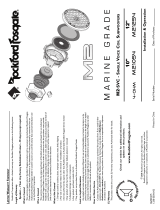 Rockford Fosgate M212S4 Installation & Operation Manual
Rockford Fosgate M212S4 Installation & Operation Manual
-
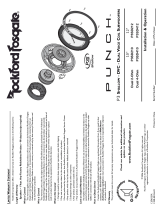 Rockford Fosgate P3SD410 User manual
Rockford Fosgate P3SD410 User manual
-
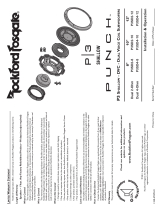 Rockford Fosgate P3 Shallow User manual
Rockford Fosgate P3 Shallow User manual
-
Rockford Prime R2D4-12 Specification
-
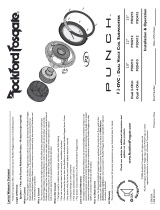 Rockford Fosgate P3D4-10 User guide
Rockford Fosgate P3D4-10 User guide
-
Rockford Fosgate P3D4-12 User manual
-
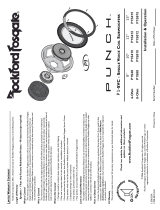 Rockford Fosgate P1S4/12 User manual
Rockford Fosgate P1S4/12 User manual
-
 Rockford Fosgate P2D212 User manual
Rockford Fosgate P2D212 User manual
-
Rockford Fosgate T1S1-10 Installation & Operation Manual
Other documents
-
Prime RM0652 Installation & Operation Manual
-
ADS S10 Owner's manual
-
Audio Design T1-DVC Owner's manual
-
Audio Design T2 Owner's manual
-
Infinity ALPHA 1200S Owner's manual
-
JBL Stage 1210 Owner's manual
-
Infinity ALPHA 1200S Owner's manual
-
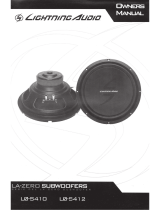 Lightning Audio L0-S412 Owner's manual
Lightning Audio L0-S412 Owner's manual
-
Orion Car Audio XTR104 User manual
-
Orion Car Audio XTRPRO152 User manual











